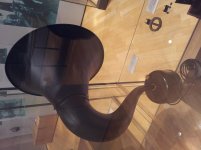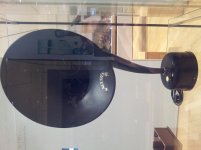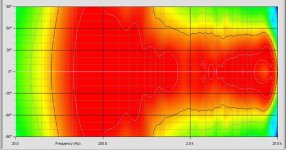It's the whole near field vs far field thing....that sound doesn't settle down to imitate a point-source, until a certain distance from the speaker.
A time honored rule of thumb is that it takes 3x longest baffle dimension to get out of speaker's near field, where good summation has yet to occur.
I've known this all along Mark, I stated that this would be a sacrifice, in 1 meter usage. I'm more concerned about the other benefits of the system than single point summation. Having such a large portion of the spectrum coming from the Axi, will ease the pain, of this sacrifice...also consider that 1 meter is just one design goal...when we watch movies the listening distance is about 2.5 meters...and thinking future forward, when I own a house, I can be more liberal to choose. Even in my current living situation I can adjust, but still, it is important to me, to take the drivers I've chosen and manipulate certain aspects to accommodate near field, as much as possible. So KA is really important.
I'd like to think of this system as a reeeaaaally big scalpel, that is large and hard to move.
One meter is nothing...good thread for those with big rooms and far listening positions.
At 1m you can put the axi on a flat baffle with a couple inches of foam on the surface crossed at 200hz and still have plenty of spl with minimal room interactions.
You need to get these puppies fired up and stop with the simulations/over-thought.
I'm designing a 3d flat pack as we speak, to be sent off for quotes from a cpl of router shops I've found.

Considering what the wood supplier just told me, to have these panels cut at a router shop is going to be considerably more expensive, I may just end up cutting them myself, but I doonntt wwannt tooooo
Last edited:
I wish i could believe that something larger than smallish monitors can work so close....
This one is amazing @1m:
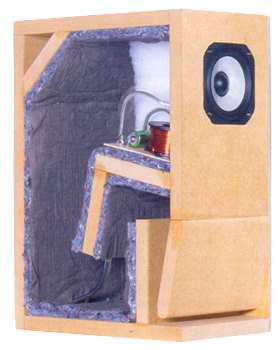
https://www.hifisound.de/out/media/...0ry0UDugb43kbnMm1OwePxz8854lNG8fqLY1CZA==.pdf
such things : FaitalPRO | HF Horns | WG141
I also guessed at 3 meters the famous 18 th sound xt was a little better fliped 90° as well at looking at the polar maps (I don't like spl curve with a bump towards 1000 Hz to 5000 hz.)
Interesting
One meter... like a nearfiel monitor...but with an axi2050.
I think that no one can perfectly predict the result because no one have tried.
But that could be a very exiting experiment.
Maybe a tiny very open waveguide, just for the transition between throat (axis) and baffle.
Inspiration here: DIY 18" elliptical waveguide with a bigger throat and shorter (only the length of the foam swimming nodle).
I'm curious to see the result.
If I find time I will try with a jbl2446 I have, just to see the result.
Next challenge: headphones with axi2050?
I think that no one can perfectly predict the result because no one have tried.
But that could be a very exiting experiment.
Maybe a tiny very open waveguide, just for the transition between throat (axis) and baffle.
Inspiration here: DIY 18" elliptical waveguide with a bigger throat and shorter (only the length of the foam swimming nodle).
I'm curious to see the result.
If I find time I will try with a jbl2446 I have, just to see the result.
Next challenge: headphones with axi2050?
Last edited:
2446 Hornless at "comfortable level" (300Hz LR24 crossover which match with the natural roll off of 4" JBL CDs and 7.5khz XO to)
Brown curve is hornless (@50cm) and cancel a 2.5hz EQ I didn't remove.
Black curve is more or less what you obtain with a "big" horn.
At this level you loose 10-15db of sensivity
3rd harmonic distorsion is rising before 600Hz with this level (maybe you could expect the same with axi2050...or less?)

At moderate level this is ok but needs EQ if you want 400hz lo level. Below that there are 300hz XO and natural roll off so it's not possible with 2446 but should be ok with axi?

I didn't add of axis measurement because at 1m listenning distance it's not very important but it's constant directivity kind of (thanks to the diffraction)
Conclusion: with your 1m listenning distance and EQ it should be possible at "moderate" level. Adding a large but short waveguide (12" large and 4" length?) should help the transition between throat and air to avoid diffraction and to help smoothing impedance curve (which should be terrible hornless). Karlson tube should be another way to try.
Good luck!
Brown curve is hornless (@50cm) and cancel a 2.5hz EQ I didn't remove.
Black curve is more or less what you obtain with a "big" horn.
At this level you loose 10-15db of sensivity
3rd harmonic distorsion is rising before 600Hz with this level (maybe you could expect the same with axi2050...or less?)

At moderate level this is ok but needs EQ if you want 400hz lo level. Below that there are 300hz XO and natural roll off so it's not possible with 2446 but should be ok with axi?

I didn't add of axis measurement because at 1m listenning distance it's not very important but it's constant directivity kind of (thanks to the diffraction)
Conclusion: with your 1m listenning distance and EQ it should be possible at "moderate" level. Adding a large but short waveguide (12" large and 4" length?) should help the transition between throat and air to avoid diffraction and to help smoothing impedance curve (which should be terrible hornless). Karlson tube should be another way to try.
Good luck!
Last edited:
Camplo, if you're looking for an example how you could create the HVdiff, there's an excellent example how to create a mould using 3D printing in the full range section of the forum: https://www.diyaudio.com/forums/full-range/352790-creating-field-coil-driver-loudspeaker-5.html#post6218986
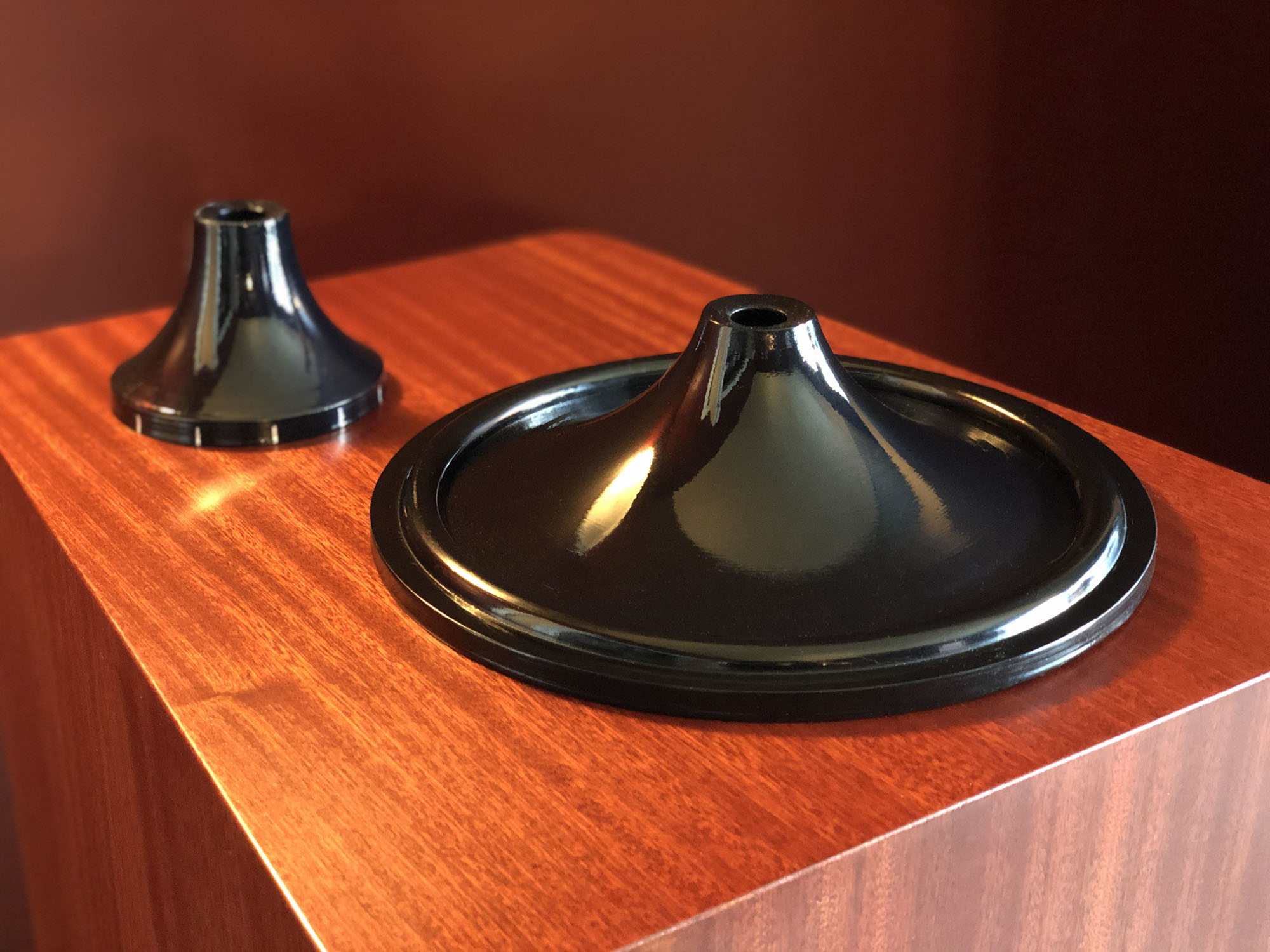
My guess is you've already seen another option of using 3D printing to aid in horn creation (for symmetrical horns)... https://www.diyaudio.com/forums/multi-way/354772-acoustic-horn-design-practical-2.html#post6214298
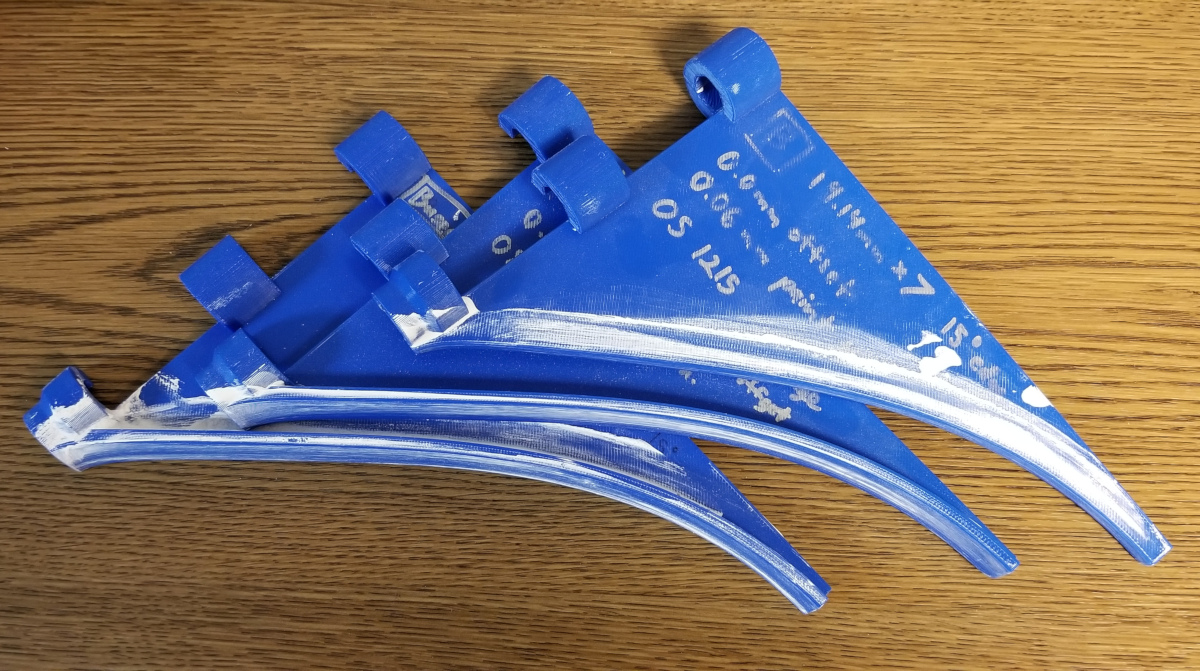
My guess is you've already seen another option of using 3D printing to aid in horn creation (for symmetrical horns)... https://www.diyaudio.com/forums/multi-way/354772-acoustic-horn-design-practical-2.html#post6214298
Vc08, the brown curve seems not so bad for a raw cd driver. Ok circa 800 hz to 8k hz without low pass but a further driver with high pass, why not a first order high pass which may match the 8 k of the 2428 ? (I think to a famous AMT  ). If I trust the spl level you measured and if the first picture is 2.8V input:
). If I trust the spl level you measured and if the first picture is 2.8V input:
The circa 10 db canyons are not worrying imho where they are : around 1 k hz, stiff. And the 2k hz to 4 khz is more a good news than a bad one ! Hummm where is Mister Bocani...
Maybe with a 99 db Faital at 800 hz +f3, given the bafle step, there will be something to do for a nice 3 way without too much effort ?! Cause with the bafle step smooth atenuation till Helmotz frequency, perhaps we may have few more db level in the critical 80-160 hz than the 4k hz to 8 khz and have subjective bass sensation...
Doable accordingthe experts here ?
The circa 10 db canyons are not worrying imho where they are : around 1 k hz, stiff. And the 2k hz to 4 khz is more a good news than a bad one ! Hummm where is Mister Bocani...
Maybe with a 99 db Faital at 800 hz +f3, given the bafle step, there will be something to do for a nice 3 way without too much effort ?! Cause with the bafle step smooth atenuation till Helmotz frequency, perhaps we may have few more db level in the critical 80-160 hz than the 4k hz to 8 khz and have subjective bass sensation...
Doable accordingthe experts here ?
Last edited:
The question is, will having such an efficient system with large drivers and large horns, provide a clearer or sharper presentation of frequency specific sound pressure level....
Oh wait, not a single person in this thread has tried it?....whoops lol
Its funny, people keep comparing what I am trying to do, to headphones....oh but wait again...sound engineers already know that headphones are more precise than loudspeakers, for the task of judging frequency specific sound pressure level aka EQ....
Headphones fall short because of the way the signal is displayed to the ear, in comparison to loudspeakers, so bass and high treble can be lost...
For my experiment I've created a system that in some ways, bridges the Gap between the two...and from where I am standing, we call that a win
So forgive me for experimenting and trying out of the box attempts at creative problem solving
I think to be fair, I should ask the audience; Has anyone tried using a large system such as this for nearfield monitoring and did it help them in the task of Eqing?....oh whats that? Non of you? Ok just checking
Ok just checking 
I can only imagine at least one person saying "Of course not, I'd never try that, it doesn't make sense

 ..." lol, I would respond, so drastically increasing Direct energy vs Room, using proximity and source size (since driver/horn/source size effects the distance and size (potency) of direct energy) which in turn gives the listener a more intimate view of the signal, makes no sense...ok bud
..." lol, I would respond, so drastically increasing Direct energy vs Room, using proximity and source size (since driver/horn/source size effects the distance and size (potency) of direct energy) which in turn gives the listener a more intimate view of the signal, makes no sense...ok bud
In the end it is my Experiment...I'm interested to hear of anyone else's experiments. I really haven't seen many out the box approaches to the task, but I'm sure if one just copies whats been done and what everyone else is doing...something new will come of it...I mean probably not, but...probably will
And I say that with a light heart and a whole bunch of sarcasm =P
Oh wait, not a single person in this thread has tried it?....whoops lol
Its funny, people keep comparing what I am trying to do, to headphones....oh but wait again...sound engineers already know that headphones are more precise than loudspeakers, for the task of judging frequency specific sound pressure level aka EQ....
Headphones fall short because of the way the signal is displayed to the ear, in comparison to loudspeakers, so bass and high treble can be lost...
For my experiment I've created a system that in some ways, bridges the Gap between the two...and from where I am standing, we call that a win
So forgive me for experimenting and trying out of the box attempts at creative problem solving

I think to be fair, I should ask the audience; Has anyone tried using a large system such as this for nearfield monitoring and did it help them in the task of Eqing?....oh whats that? Non of you?
 Ok just checking
Ok just checking 
I can only imagine at least one person saying "Of course not, I'd never try that, it doesn't make sense


 ..." lol, I would respond, so drastically increasing Direct energy vs Room, using proximity and source size (since driver/horn/source size effects the distance and size (potency) of direct energy) which in turn gives the listener a more intimate view of the signal, makes no sense...ok bud
..." lol, I would respond, so drastically increasing Direct energy vs Room, using proximity and source size (since driver/horn/source size effects the distance and size (potency) of direct energy) which in turn gives the listener a more intimate view of the signal, makes no sense...ok budIn the end it is my Experiment...I'm interested to hear of anyone else's experiments. I really haven't seen many out the box approaches to the task, but I'm sure if one just copies whats been done and what everyone else is doing...something new will come of it...I mean probably not, but...probably will

And I say that with a light heart and a whole bunch of sarcasm =P
Last edited:
If you are going to be listening at 1 meter, most of this thread is irrelevant to you.. this is all big room and/or long throw type gear
I mean you can do it, it's your life, but it's not going to be very good
For close listening, you want wider dispersion at the high end and you should consider point source type arrangements, be it coaxial or a synergy horn type setup. You should be able to get something out there that will do 110db/m fairly easily
edit: This is the epitome of analysis paralysis. I have almost finished my high sensitivity 2 way home setup that I started after this thread started, and have almost finished a couple of other speakers too.. while doing it way too slow. Please for the love of god build something
I mean you can do it, it's your life, but it's not going to be very good
For close listening, you want wider dispersion at the high end and you should consider point source type arrangements, be it coaxial or a synergy horn type setup. You should be able to get something out there that will do 110db/m fairly easily
edit: This is the epitome of analysis paralysis. I have almost finished my high sensitivity 2 way home setup that I started after this thread started, and have almost finished a couple of other speakers too.. while doing it way too slow. Please for the love of god build something
Last edited:
I'm not really sure, I should have ignored it.
Well I think you should debate it, you usually have really good input =)
If you are going to be listening at 1 meter, most of this thread is irrelevant to you.. this is all big room and/or long throw type gear
I mean you can do it, it's your life, but it's not going to be very good
For close listening, oohms wants wider dispersion at the high end and you should consider point source type arrangements, be it coaxial or a synergy horn type setup. You should be able to get something out there that will do 110db/m fairly easily
- this part...I've asked before for everyone to stop being so general. We are all capable of being very specific....What would you consider to be the smallest tolerable beam width?For close listening... wider dispersion at the high end
~110db? maybe 114db? from 1 meter away. I can't find a frequency chart on the Dynaco A-50's but, full range for my application will be linear down to 30hz.
This is post #5 of My thread, the whole thread, which I've read daily, has been relevant...to me.
edit: This is the epitome of analysis paralysis. I have almost finished my high sensitivity 2 way home setup that I started after this thread started, and have almost finished a couple of other speakers too.. while doing it way too slow. Please for the love of god build something
Omg ooohms lol! Why does everyone keep saying that! I am working towards that already, I have already settle on a design, I'm working on getting the wood cut!!! lol!
I know what I am doing, btw, as far as over analyzing and what not, I'm ok with it, and it has been a very good thing for the design...Literally, the design would not look as it does now, If I had of "just built it already"....its the journey my brother, the jooouurrnneeyyyy...I really like what the build has turned into... and it took a long time to turn into this...at one point I was going to build with a horn and 2 15m's per side...now look at it! Trust the process! At another time I was about to build a TL....TL taught me so much that I didn't build one lol! But I was smart enough to recognize that the original sealed system I always wanted....was only lacking the second output, reminiscent of a vented design but better...I added another woofer . Now I have that....trust the process! Then I obsessed over getting the 2 outputs on one plain, on the front baffle...now look at it!...Trust the process!
As you were saying
I've asked before for everyone to stop being so general. We are all capable of being very specific....What would you consider to be the smallest tolerable beam width?
Last edited:
Ha Ha, well you will catch more flies with honeyWell I think you should debate it, you usually have really good input =)
I think you should build the design you have, listen to it nearfield for mixing/mastering and then listen more farfield at your back couch and report back.
The thing you were right about is that you won't find many (if any) people that have used this same type of setup for the same purpose as you intend.
If it were me I would want the woofers in the horn like a synergy to get a better shot at the wavefronts integrating at a short distance.
The reason that nearfield, midfield and Main monitor systems exist in professional studios is because they fill different roles. It is hard to design a speaker to work properly over a significantly variable listening distance. DSP active with multiple presets can go some way to help.
- this part...I've asked before for everyone to stop being so general. We are all capable of being very specific....What would you consider to be the smallest tolerable beam width?
Generally, as wide as possible, unless you need to restrict it because of room acoustics.
I prefer studio monitor type speakers with 1" waveguide loaded dome tweeters and 5-8" woofers for that kind of distance, my favourite being the old behringer B2031A.
Flat Response -
Techtalk Speaker Building, Audio, Video Discussion Forum
Attachments
Ha Ha, well you will catch more flies with honey
I think you should build the design you have, listen to it nearfield for mixing/mastering and then listen more farfield at your back couch and report back.
The thing you were right about is that you won't find many (if any) people that have used this same type of setup for the same purpose as you intend.
If it were me I would want the woofers in the horn like a synergy to get a better shot at the wavefronts integrating at a short distance.
The reason that nearfield, midfield and Main monitor systems exist in professional studios is because they fill different roles. It is hard to design a speaker to work properly over a significantly variable listening distance. DSP active with multiple presets can go some way to help.
Sorry if I come off aggressive, its a road construction thing...I've been amidst my work family. I really do enjoy you guy's company.
The problem in my head about the synergy is...what size will this be...what would it look like? I mean the Axi is prefect for use in such a thing, but to me, the way I have it set up now, with what looks like less of a challenge now due to recent Axi data, crossing as low as 200hz is going to be a reality. Having ~200hz-20.000khz is very Synergy like is it not?
- Home
- Loudspeakers
- Multi-Way
- Is it possible to cover the whole spectrum, high SPL, low distortion with a 2-way?
